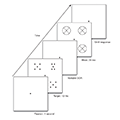Abstract
Many studies of cognition and perception use a visual mask to explore the dynamics of information processing of a target. Especially important in these applications is the time between the target and mask stimuli. A plot of some measure of target visibility against stimulus onset asynchrony is called a masking function, which can sometimes be monotonic increasing but other times is U-shaped. Theories of backward masking have long hypothesized that temporal integration of the target and mask influences properties of masking but have not connected the influence of integration with the shape of the masking function. With two experiments that vary the spatial properties of the target and mask, the authors provide evidence that temporal integration of the stimuli plays a critical role in determining the shape of the masking function. The resulting data both challenge current theories of backward masking and indicate what changes to the theories are needed to account for the new data. The authors further discuss the implication of the findings for uses of backward masking to explore other aspects of cognition.
